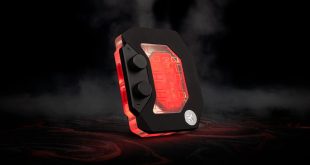The Asus GTX 680 Direct CU II TOP is a custom design and features a backplate. We need to remove the cooler and backplate completely before installing the ARCTIC Accelero Xtreme II.
The first step requires the removal of the four main spring based GPU screws.
Above, the triple slot ASUS cooler – it is a formidable design, comprising five thick copper heatpipes running from the core in one direction, with two of them then bending back into a smaller rack of aluminum fins underneath one of the fans above. The other three copper heatpipes run straight out into a larger set of aluminum fins underneath the second fan.
Above, the ARCTIC Accelero Xtreme III. ARCTIC have pre-applied a generous amount of high grade thermal paste to save you the hassle.
The cooler is formed around a copper base with five 6mm heatpipes which lead into two separate racks of aluminum fins on either side. The three 92mm fans run the full length of the cooler, ensuring extensive ‘direct down' airflow.
Unlike the ASUS Direct CU II cooler, none of these pipes are bent, leading straight from the copper block in two directions.
Removing the backplate takes a few minutes as there are multiple screws, including two on the I/O panel. Be sure to remove the cooling heatsink over the VRM's.
Above we took a picture of the naked card with eight of the ram cooling heatsinks underneath. We recommend taking a few minutes now with an eraser, gently rubbing each memory module, to ensure they are perfectly clean for the adhesive bonding stage shortly. The rubber tip of a pencil works well for this.
We realised at this stage that this ASUS Top graphics card is significantly different from the reference GTX 680 and that the ARCTIC diagrams didn't directly relate.
The first stage is straightforward, using the thermal glue to adhere the heatsinks to each of the Hynix GDDR5 memory modules around the core. The key to this stage is to use very little of the thermal glue, holding each heatsink in place for around 30 seconds. If you use too much glue the card can quickly end up a mess, potentially causing problems later on.
Also pay attention to the spacing, leaving enough room around the core to fit the bracket. It isn't rocket science, just line up each heatsink with the memory underneath, making sure it doesn't overhang on the inside.
All the heatsinks installed around the GPU core. While they are bonding into place, a little care is required when handling as we have other sections to work with now.
Thinking outside the box – this card is no reference design.
The ASUS TOP is very different in design to the reference GTX680, so we used heatsinks included for other cards on these sections. A little time and care is required to line these up right, taking care not to use excessive thermal glue.
All of the heatsinks installed. We recommend letting these bond into place for around 90 minutes before working any further with the card. If you have used an excessive amount of thermal glue then this bonding phase may take 3-4 hours.
With the heatsinks all bonded, flip the card over and remove the adhesive cover on the foam pad. Stick this into the center of the four screw holes, as shown above.
Locate the small clear plastic bag with the GPU mount components. There are four screws in this, and multiple spacers. ARCTIC also include adhesive pads which stick to the spacers.
The GTX680 uses the 4.5 mm washers on the CPU block. You are meant to bond these to the adhesive paper style pads then stick them to the outermost of the three holes on each corner of the cooling head as shown above.
Even though I have used a similar system before with other ARCTIC cards I had a terrible experience this time and binned the adhesive pads completely, opting to use a little of the remaining thermal glue to hold them in place.
The black spacers are used on the back plate, between the metal plate and the GTX680 PCB. This prevents an electrical short and damage to the card. It is best holding the PCB with the rear facing you, with the cooler underneath, lined up by eye. Feed the screws through the black spacers, through the PCB, then through the white spacers on the copper head of the Xtreme III. If you haven't got the white spacers held in place this can be extremely tricky.
The ARCTIC Accelero Xtreme III installed, above. The only downside is that it overhangs the total length of the GTX680 PCB, measuring 288mm.
As we mentioned earlier, the Asus GTX 680 Direct CU II TOP falls outside the reference guidelines and the ARCTIC Accelero Xtreme III hasn't got a suitable 5 pin header for this graphics card (a 3 pin and 4 pin are included). Thankfully ARCTIC have factored this as a potential issue and have included a MOLEX adapter with the cooler taking power directly from the system supply.
If you are an inexperienced user I wouldn't recommend you try fitting this cooler, it takes a lot of time and a reasonable amount of skill to install properly. ARCTIC need to head back to the drawing board and come up with a slightly less fiddly ‘spacer' solution. I can appreciate that they couldn't make a dedicated cooler for every video card, but the adhesive pad/spacer stage of the install is less than ideal.
 KitGuru KitGuru.net – Tech News | Hardware News | Hardware Reviews | IOS | Mobile | Gaming | Graphics Cards
KitGuru KitGuru.net – Tech News | Hardware News | Hardware Reviews | IOS | Mobile | Gaming | Graphics Cards


















